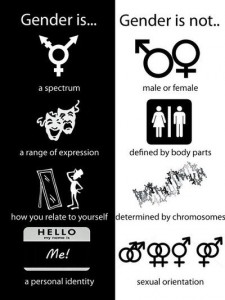I found the discussion on Post-Gay that we looked at in class this week and examined in Jennifer Reed’s ‘The Three Stages of Ellen’ rather problematic. In individualising peoples identities beyond the need of categorizing, ideas of post-gay and post-human teach us that human expression is diverse and equally valid. This breakdown of recognition moves us beyond hegemonic norms and works to depoliticise people’s identities and makes them irrelevant.
As pointed out in class, this function of ‘post’ works to re-establish dominant norms and reaffirms the status quo. Due to this, it makes it difficult to subvert structures of power. Towards the end of class we started to look at technologies of gender. Clothing, toys, bathrooms etc, and it became clear that society is structured around the gender binary. What the notion of ‘post’ does is to teach that although we understand that there are inequities in social structures, understanding them and acknowledging them is enough.
This is clearly problematic for many reasons, notably through notion of binary thinking. To think that gender is a binary is simply narrow-minded thinking in contemporary society and must be debunked. Instead, gender needs to be understood as a spectrum. Gender literacy around identity, expression, and orientation must be improved. Our assigned birth sex is about biology. Our gender expression is about how one presents oneself as a gendered person. Our gender identity regards how we see ourselves. Our orientation is about who we want to have sex with. Each of these components are fluid and non-binary, and fall within a spectrum that each person identifies differently with. It is important to understand that acknowledge that gender is attached to complex, multidimensional social location rather than just one factor, and we must try to actively think against binary ideas.
The discussion regarding transgender people and bathrooms sparked a bit of controversy in the classroom this week. Whilst some acknowledged that someone of the opposite gender in a female bathroom or vice versa can often be connoted with a threat of violence in that space, others did not share the same expression. I personally believe that there should be additional bathrooms which are not gendered and are welcome by anyone who wishes to use them. However, I do also believe that a transgender woman, who identifies with being a woman as much as I do, should be allowed to enter a female bathroom without receiving any form of discrimination or resistance, and vice versa with transgender men in male bathrooms. How can I possibly judge a person on their gender identity and expression, and address how they are supposed to navigate that in society?

-Aimee